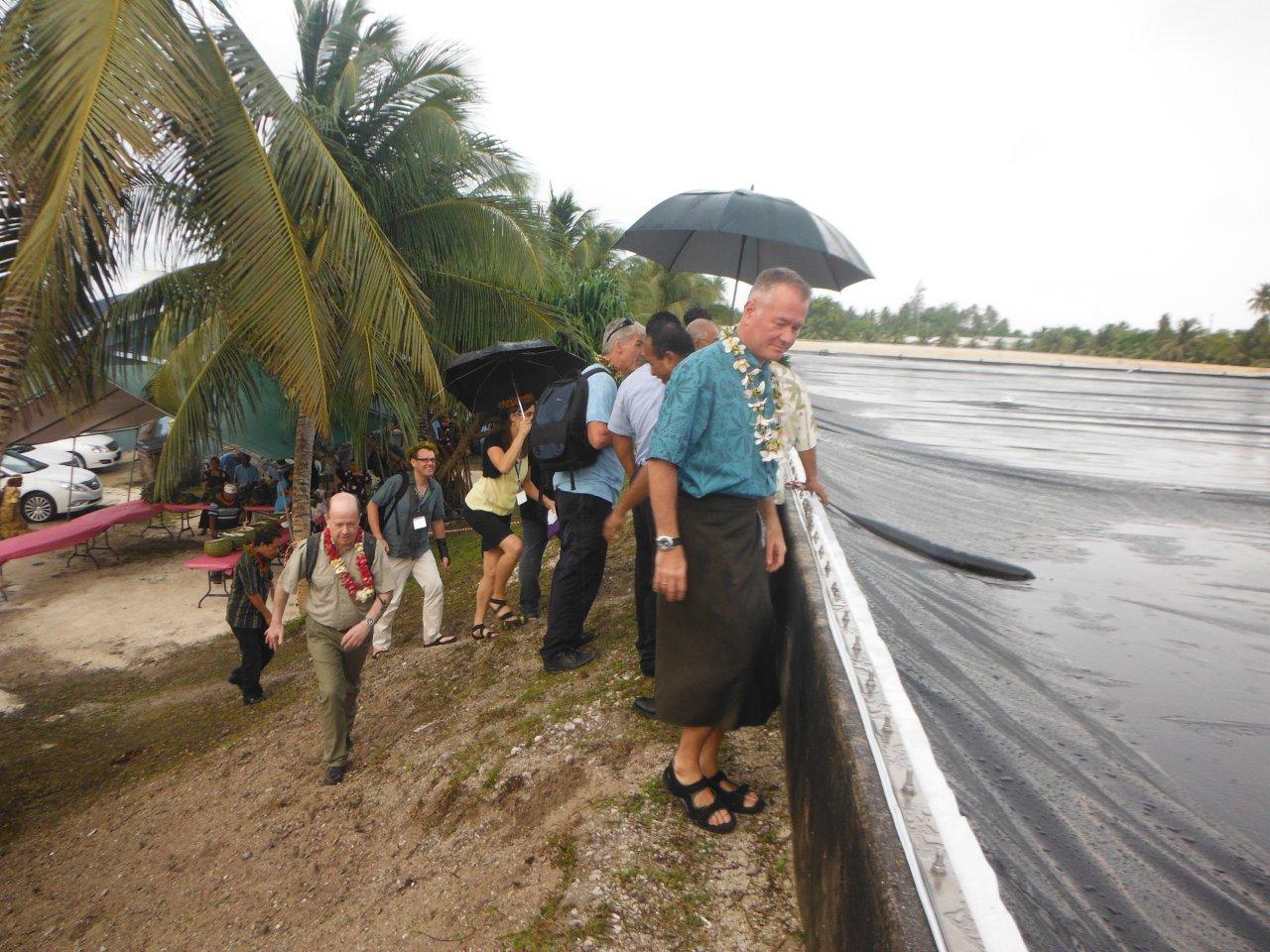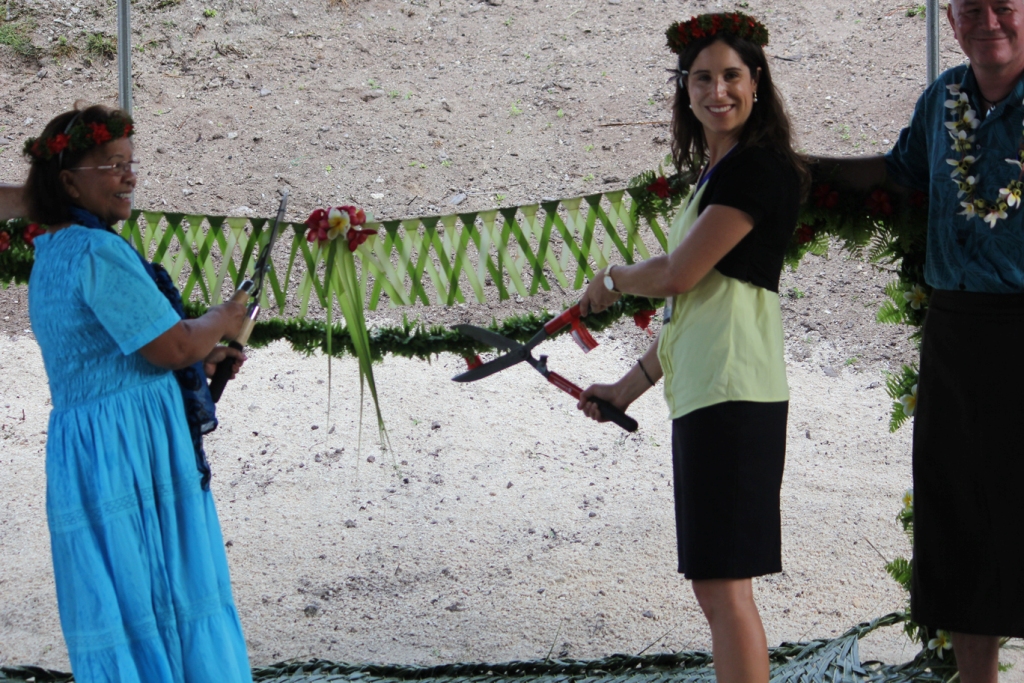
Climate Change Resilience
Majuro, the main atoll in the Marshall Islands, witnessed the opening of its newly renovated reservoir on 2nd April, in a ribbon-cutting ceremony led by the nation’s president Christopher Loeak. The opening represented the culmination of several years’ work by the Pacific Adaptation to Climate Change (PACC) project and partners, which aimed at increasing the resilience of the atoll nation to the impacts of climate change. The reservoir, which is the major source of freshwater for the 28,000 people of Majuro, now has both increased capacity and measures to reduce evaporation loss, meaning that the island’s water supply is much more resilient to the periodic droughts suffered by the country.


Top: Espen Ronneberg, SPREP Climate Change Adviser and dignitaries at one of the newly renovated reservoirs.
Bottom: First Lady Mrs Loeak and Alexandria Rantino of Australia DFAT cut the ribbon
Representing the PACC implementing agency, the Secretariat of the Pacific Regional Environment Programme (SPREP), Climate Change Advisor Espen Ronneberg, said the reservoir renovations and related activities represented “real, tangible adaptation on the ground”. He outlined the process followed by the project in deciding what activities to undertake, beginning with an assessment of vulnerability to climate risks, appraisal of adaptation capacity and options, and the use of cost–benefit analysis to narrow down the actions that would give the best returns for investment. The end result, he said, is “a healthy water supply for the people of Majuro”.
The catchment for the reservoir is the island’s largest paved area – the runway at the international airport. Water is diverted to the reservoir tanks where it is treated and piped to communities. However, outdated infrastructure compounded by unpredictable and often challenging weather meant that the system was becoming inadequate for the increasing population.
The reservoir capacity has been increased from 32 million gallons to 36.5 million gallons (approximately 138 million litres). Covers have also been fitted to the tanks, reducing loss from evaporation. Further improvements are also planned, pending funding.
“This is an important achievement for our country,” said Marshall Islands PACC Project Coordinator Joseph Cain. “Water security is one of the biggest challenges for small low-lying islands, and we also need to factor in the uncertainties of climate change. Practical steps like this one help us to face these uncertainties with more confidence.”
The Republic of the Marshall Islands is one of 14 countries participating in the PACC programme, the largest climate change adaptation initiative in the Pacific region. The country projects are demonstrating practical measures to build resilience to climate change with focus on three key climate-sensitive sectors: coastal zone management, food production and food security, and water resources management. The countries are also working to mainstream climate change and climate risk into all development activities, for example through climate-responsive policy and planning.
The PACC programme is funded by the Global Environment Facility and the Australian Government with support from the United Nations Institute for Training and Research (UNITAR) Climate Change Capacity Development (C3D+). The Secretariat of the Pacific Regional Environment Programme (SPREP) is the implementing agency, with technical and implementing support from the United Nations Development Programme (UNDP).


Top: Espen Ronneberg, SPREP Climate Change Adviser and dignitaries at one of the newly renovated reservoirs.
Bottom: First Lady Mrs Loeak and Alexandria Rantino of Australia DFAT cut the ribbon
Representing the PACC implementing agency, the Secretariat of the Pacific Regional Environment Programme (SPREP), Climate Change Advisor Espen Ronneberg, said the reservoir renovations and related activities represented “real, tangible adaptation on the ground”. He outlined the process followed by the project in deciding what activities to undertake, beginning with an assessment of vulnerability to climate risks, appraisal of adaptation capacity and options, and the use of cost–benefit analysis to narrow down the actions that would give the best returns for investment. The end result, he said, is “a healthy water supply for the people of Majuro”.
The catchment for the reservoir is the island’s largest paved area – the runway at the international airport. Water is diverted to the reservoir tanks where it is treated and piped to communities. However, outdated infrastructure compounded by unpredictable and often challenging weather meant that the system was becoming inadequate for the increasing population.
The reservoir capacity has been increased from 32 million gallons to 36.5 million gallons (approximately 138 million litres). Covers have also been fitted to the tanks, reducing loss from evaporation. Further improvements are also planned, pending funding.
“This is an important achievement for our country,” said Marshall Islands PACC Project Coordinator Joseph Cain. “Water security is one of the biggest challenges for small low-lying islands, and we also need to factor in the uncertainties of climate change. Practical steps like this one help us to face these uncertainties with more confidence.”
The Republic of the Marshall Islands is one of 14 countries participating in the PACC programme, the largest climate change adaptation initiative in the Pacific region. The country projects are demonstrating practical measures to build resilience to climate change with focus on three key climate-sensitive sectors: coastal zone management, food production and food security, and water resources management. The countries are also working to mainstream climate change and climate risk into all development activities, for example through climate-responsive policy and planning.
The PACC programme is funded by the Global Environment Facility and the Australian Government with support from the United Nations Institute for Training and Research (UNITAR) Climate Change Capacity Development (C3D+). The Secretariat of the Pacific Regional Environment Programme (SPREP) is the implementing agency, with technical and implementing support from the United Nations Development Programme (UNDP).